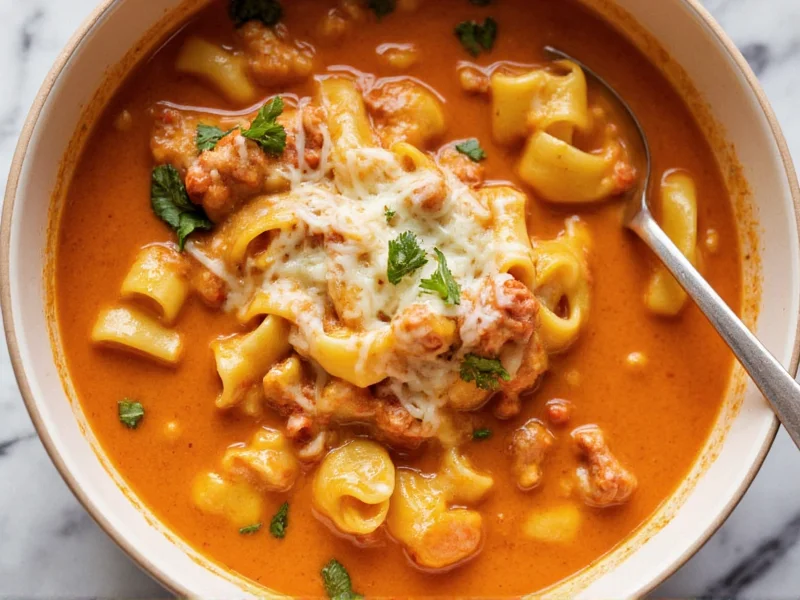The Essential Elements of Perfect Creamy Lasagna Soup
Crafting an exceptional creamy lasagna soup requires understanding the balance between traditional lasagna components and soup-friendly adaptations. Unlike standard tomato-based pasta soups, this dish achieves its signature richness through strategic ingredient selection and preparation methods that maintain structural integrity while delivering that luxurious mouthfeel.
Why Traditional Lasagna Transforms Perfectly Into Soup
The magic of creamy lasagna soup lies in its ability to capture lasagna's essence while solving common pasta dish limitations. By converting layered components into a cohesive broth, you eliminate uneven cooking and cheese separation issues while preserving the comforting cheese-pasta-tomato trifecta that defines lasagna.
| Ingredient | Traditional Lasagna Role | Soup Adaptation | Key Benefit |
|---|---|---|---|
| Ricotta Cheese | Layer filling | Whisked into broth | Creates creamy base without curdling |
| Mozzarella | Melted topping | Added at end | Maintains distinct cheese pockets |
| Lasagna Noodles | Structural layers | Cut into strips | Provides familiar texture without sogginess |
| Meat Sauce | Between layers | Built into broth | Ensures even flavor distribution |
Mastering the Creamy Texture Without Curdling
Many home cooks struggle with achieving true creaminess without dairy separation. The secret lies in temperature control and ingredient sequencing. Always incorporate dairy products like ricotta or cream cheese off-heat, gradually tempering them with warm broth before returning to the pot. This prevents the proteins from seizing and ensures a smooth, homogeneous texture that defines authentic creamy lasagna soup.
For dairy-free versions that maintain richness, consider blending soaked cashews with vegetable broth or using pureed cannellini beans. These alternatives provide similar mouthfeel while accommodating dietary restrictions without sacrificing the essential creamy lasagna soup experience.
Step-by-Step Preparation Guide
Begin by sautéing onions, garlic, and your choice of ground meat (beef, Italian sausage, or plant-based alternative) until properly browned. Deglaze the pot with red wine to lift flavorful fond, then add crushed tomatoes, tomato paste, and vegetable or meat broth. Simmer for 20 minutes to develop depth before introducing pasta.
Cut lasagna noodles into ½-inch strips and cook separately until al dente to prevent overcooking in the soup. This separate preparation technique ensures perfect noodle texture in your homemade creamy lasagna soup. When combining elements, add the cooked noodles just before serving to maintain their structure through multiple servings.
Avoiding Common Creamy Lasagna Soup Mistakes
Overlooking pasta preparation remains the most frequent error in creamy lasagna soup recipes. Adding uncooked noodles directly to the soup guarantees mushy results as they continue cooking in residual heat. Similarly, adding cheese while the soup boils causes immediate curdling - always remove from heat before incorporating dairy components.
Another critical consideration involves seasoning timing. Salt levels change dramatically as pasta absorbs liquid, so final seasoning adjustments should occur after noodles have been incorporated. This attention to detail separates adequate attempts from truly exceptional creamy lasagna soup that rivals restaurant versions.
Delicious Variations for Every Preference
Vegetarian creamy lasagna soup shines when substituting meat with mushrooms, eggplant, or lentils while maintaining umami depth through tomato paste and Parmesan rind. For gluten-free preparation, use certified GF lasagna noodles cooked separately and added at serving time to prevent disintegration.
Regional adaptations offer exciting possibilities: add a pinch of red pepper flakes for Italian-American heat, incorporate roasted red peppers for Spanish influence, or finish with fresh basil pesto for a vibrant flavor boost. These creative twists on classic creamy lasagna soup keep the dish feeling fresh while honoring its comforting roots.
Serving and Storage Best Practices
Serve creamy lasagna soup immediately after preparation for optimal texture, garnished with fresh basil, grated Parmesan, and a swirl of cream. The soup performs exceptionally well as meal prep when stored properly - keep components separate (broth, noodles, cheese) and combine only when reheating to maintain ideal consistency throughout the week.
When reheating, use low temperatures and stir frequently to prevent separation. If texture issues occur, a quick immersion blender pass restores creaminess without altering flavor. These storage techniques ensure your creamy lasagna soup remains restaurant-quality through multiple servings, making it ideal for weekly meal planning.
Can I make creamy lasagna soup without heavy cream?
Yes, you can create creamy lasagna soup without heavy cream by using ricotta cheese blended with broth, pureed white beans, or cashew cream. These alternatives provide similar richness while being lighter and accommodating various dietary needs without compromising the essential creamy texture.
How do I prevent my creamy lasagna soup from curdling?
Prevent curdling by removing the soup from heat before adding dairy, gradually tempering cold dairy with warm broth, and avoiding boiling after dairy incorporation. Using full-fat dairy products and maintaining temperatures below 180°F (82°C) preserves the smooth texture essential to perfect creamy lasagna soup.
What's the best pasta substitute for gluten-free creamy lasagna soup?
The best gluten-free option is using certified gluten-free lasagna noodles cooked separately and added just before serving. Alternatively, thinly sliced zucchini or eggplant ribbons provide low-carb alternatives that maintain the layered lasagna concept while ensuring your creamy lasagna soup remains gluten-free without texture compromise.
How long does creamy lasagna soup stay fresh in the refrigerator?
Properly stored in an airtight container, creamy lasagna soup maintains quality for 3-4 days in the refrigerator. For best results, store components separately (broth, noodles, cheese) and combine only when reheating to prevent pasta from becoming mushy and dairy from separating during storage.
Can I freeze creamy lasagna soup successfully?
Yes, but with modifications for optimal results. Freeze the tomato broth base without dairy or pasta, then add fresh noodles and cheese when reheating. Dairy components don't freeze well and will separate upon thawing, so this approach preserves the creamy texture that defines authentic creamy lasagna soup when you're ready to serve.











 浙公网安备
33010002000092号
浙公网安备
33010002000092号 浙B2-20120091-4
浙B2-20120091-4